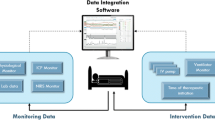Abstract
16 experienced ICU nurses monitored simulated central station VDU displays for the occurrence of ectopic beats and for signs of deterioration in general cardiovascular status. Each period of monitoring lasted for 1 h, and on separate occasions each nurse monitored 1, 2, 4 or 6 displays simultaneously. As the number of observed screens increased, performance declined significantly, with reduced identifications of discrete events (e.g., ectopic beat detections), and with increased delays in determining a deterioration in cardiovascular status; in addition, a secondary task was less accurately and efficiently performed, and the nurses tended to become increasingly fatigued. Efficient observing was maintained over the 1 h monitoring period, but only at considerable cost in terms of fatigue and a loss of alertness. The results suggest that there may be restrictions in the use of complex central station facilities as first-line observation posts for patient care.
Similar content being viewed by others
References
Craig A (1984) Human engineering: The control of vigilance. In: Warm JS (ed) Sustained attention in human performance. Wiley, Chichester, pp 247–291
Craig A, Colquhoun WP (1975) Vigilance: A review. In: Drury CG, Fox JC (eds) Human reliability in quality control. Taylor and Francis, London, pp 71–88
Crew AD, Stoodley KDC, Naghdy F, Unsworth CD (1984) Preliminary studies in the identification of cardiac status in a cardiac surgical intensive therapy unit. Intensive Care med 10:71–78
Crew AD, Old S, Craig A, Unsworth CG, Fletcher PC (1989) Central Station Data Displays: An experimental evaluation of observer performance. Part 2. Factors affecting performance, and a comparison of analogue and digital data. Intensive Care Med 15 (in press)
Daly BJ, Wilson CA (1983) The effect of fatigue on the vigilance of nurses monitoring electrocardiograms. Heart Lung 12:384–388
Johns LA (1969) An experimental approach to vigilance in nurse-patient monitoring. Comm Nurs Res 3:129–145
Lindsay J, Bruckner N (1975) Conventional coronary care unit monitoring — non-detections of transient rhythm disturbances. JAMA 232:51–53
Mackworth NH (ed) (1957) Vigilance, the advancement of science, pp 389–410
Muirhead RC (1980) Nursing evaluation of monitoring methods in CCU. Supervisor Nurse
Naghdy F, Stoodley KDC, Henry RM, Crew AD (1984) Development of a microprocessor-based monitoring system for postsurgical cardiac patients. J Microcomp App 7:41–49
Stoodley KDC, Naghdy F, Crew AD (1982) Monitoring of cardiovascular variables in a post-surgical cardiac intensive care unit. In: Anderson OD (ed) Time series analysis: theory and practice I. North-Holland, Amsterdam Oxford New York, pp 123–137
Stoodley KDC, Lu R, Crew AD, Henry RM (1984) A microprocessor-based immediate alarm system for post-surgical cardiac patients. In: Quetglas GM, MacFarlane PW, Perez DE, Talens AF, Aguilar JC (eds) The application of computers in cardiology: state of the art and new perspectives. Elsevier (North-Holland), Amsterdam, pp 385–388
Wickens CD (1984) Engineering psychology and human performance. Merrill, Columbus, Ohio
Wilkinson RT (1960) The effects of lack of sleep on visual watchkeeping. Q J Exp Psychol 12:36–40
Winer BJ (1962) Statistical principles in experimental design. McGraw-Hill, New York
Author information
Authors and Affiliations
Rights and permissions
About this article
Cite this article
Crew, A.D., Old, S., Graig, A. et al. Central station data displays: an experimental evaluation of observer performance. Intensive Care Med 15, 314–318 (1989). https://doi.org/10.1007/BF00263867
Received:
Accepted:
Issue Date:
DOI: https://doi.org/10.1007/BF00263867




